Created By Morgan Harker for La Chicana In Society Class
Don't wanna be here? Send us removal request.
Text
Borderlands Blog Entry #10 Reflection
For my reflection, I want to talk about my own identity! I am white, so learning about the people who identify as mestiza, or people who are other, or people who are multicultural has been very interesting for me throughout my time reading this book. I have learned the way that white people oppress these individuals, and have also learned more about the experiences that borderlands people face from other cultures. I am able now to understand the more complex identities that Chicanx people have, and am able to view the world in a more understanding way using a duality-based lens. I have been able to reflect on my own experiences and also the experiences of my peers in this class through how I may understand how they can relate to the parts of this book. Anzalduan theory has certainly struck a chord with me because I am now able to understand other’s experiences in a way that helps me simply understand without having to voice my opinion on it. This book has taught me a lot of new ideas when it comes to Chicanos and other mixed people. I am now able to appreciate people’s individuality and uniqueness even more and understand that borderlands are not just a place but an identity, and that everyone has many unique aspects of their life experiences that create their identity.
0 notes
Text
Borderlands Blog Entry #9 Sections IV, V, and VI
Section IV, Letting Go
This poem was very strange to me but also very beautiful. At first I was lost because I did not understand what it meant to rip yourself open, but the more I read the more I understood that maybe you have to rip yourself open to get the bad things out so that you can continue to grow and let go and be better. I also really enjoyed the part of this poem wherein it explains that nobody else will fight the dragon, or rescue you, or climb your hair, or fill your need. You have to do it yourself. I think that the overall connection that I had with this was that you have to let go of the things you are dependent upon and learn to be independent within yourself. I think that it is also interesting in the end because the final line is that “gills grow on your breasts” (188). This reminds me of a mermaid, so it is interesting because I think the other elements of this poem are that fairy tales are not real and you cannot depend on someone else to save you, but once you learn to do it yourself, you become a creature of a fairytale so you are somewhat fulfilling your own needs.
Section V, Creature of Darkness
To me, this poem seemed to be a metaphor for depression. It talks about the dark place being a place of grieiving. It brings up the person not wanting to think anything that would bring back the pain, and it also talks about how the writer lies to their friends so that they don’t try to help take the person out of the dark place. The writer talks about eating to smother the loss and becoming numb. I think that this is something a lot of people relate to and that each stanza of this poem describes depression in a different way that many people can identify with. I think that this is also symbolism for the stuck feeling that many people get when they are facing hard times and oppression and how they do not want to move from the dark place that they are both comforted by and scared of. I think that this depression/oppression comparison is relevant to how peopl are othered because of their mental health.
Section VI, To live in the Borderlands means you
To me, this poem was less of a metaphor and more of a description of what it means to be a citizen of the borderlands, and to be mestiza. It is all about understanding the duality of yourself and how to interpret how others will view you and be prepared for it. Many will see you as betraying one culture or another, when really you find comfort in knowing you are a combination of the two. It also describes the different forms of oppression and prejudice that mixed peoples face, because they don’t fit into one specific category. This poem helped me to understand how hard it is for people to be Bordered and othered, but also how beautiful it is for them to be seen as a crossroads without borders.
0 notes
Text
Borderlands Blog Entry #8 Sections I, II, and III
Section I, Cervicide
In this poem, there is a story being told of a young girl, called Prieta (which is a nickname meaning one who is dark-skinned) has to kill a baby deer that her and her family had been raising as a pet because the game warden was coming to their house and the penalty for owning a deer would be jail or a $250 fine. The fawn is essentially a symbol of the young woman, and in archetypal symbology, the self is a deer for women. Essentially, this story is a metaphor for the young woman killing herself to keep her family from getting in trouble. In the end, the girl kills the fawn and successfully hides it from the Sheriff and his hounds. But the overarching message that I got from this poem was that the young girl had to kill herself to keep her family safe and made the sacrifice to conform and do what was expected to ensure that her family was not punished. This basically is symbolism for the borders that the young woman was kept in. Her mother could not kill the deer and she did not want her father to go to jail for owning the deer, so she sacrificed herself for them. I think that this plays into how young Chicana women sacrifice so much of their potential identities to adhere to their families expectations and can even be connected to the pressure and fear that Anzaldua felt when she was trying to create her own identity but did not want her family to suffer because she was going outside of their expectations.
Section II, A Sea of Cabbages
This poem to me was all about the work and suffering that men did working in the fields. Throughout the poem, it is hinted that the man working in the fields is growing tired and sick. There is mention of his arthritic arms, his occasional curses, and him bending over but living face up. The part where the sun is a cracking rock on his back, and how he cannot escape his own snare. This poem makes me feel as though this is the experience of the men who worked in the fields to support their families and the exhaustion and desperation they felt. I think it is also symbolic of the oppression these Chicano farmworkers faced and how they were stuck in the sea of oppression and drowning in it like the man in this poem is in the constant cycle of the sea of cabbages.
Section III, The Cannibal’s Cancion
This poem was very interesting to me in general because it talks about cannibalism. One of the parts of this poem that stood out to me the most was the beginning, “It is our custom to consume the person we love” (165). I think that this was the most standout part of the poem because it is basically a metaphor for how we tend to get so consumed by the person that we love and we tend to consume them to so that we are intertwined with them in a way that we are not with anyone else. Then the ending talks about going to Mass and communion and putting the person’s relics to rest. I think that this is a symbol for Anzaldua of how religion can sometimes wake a person up and force them to come back down to earth. In this case it is forcing the cannibal to return the bodyparts to rest but I think in other instances it might be to remind queer people like Anzaldua that they are wrong in the way they love someone. I took this poem as a description of how religion limited her experiences of love until she broke free from those restrictions. To the church, queerness could be considered just as big a crime as cannibalism.
0 notes
Photo
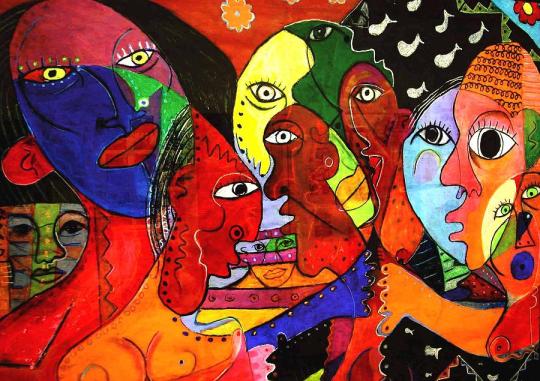
Borderlands Blog
Ch. #7: La conciencia de la mestiza/ Towards a New Consciousness
A quote from this chapter that seemed very prevalent to me is when Anzaldua says, “la mestiza is a product of the transfer of the cultural and spiritual values of one group to another. Being tricultural, monolingual, bilingual, or multilingual, speaking in a patois, and in a state of perpetual transition, the mestiza faces the dilemma of the mixed breed...” (100). I think that in just those two sentences, Anzaldua gives an image of what it is like to be someone who is multicultural and has faced many different experiences because of this intersectionality. The writing that she does in this chapter allowed me to understand the complicated and confusing existence that being mestiza is like and how it is hard to develop your own identity that makes you happy when you have different cultural expectations imposed upon you from different cultures of your life. To me, I feel as though the mestiza are in some way a culture of borderlands people mentally and identity-wise because they are a combination of so many values that differ and concur with one another. This art piece, by Robert Daniels, really symbolized this idea to me because it is a complete combination and construction of so many different faces and colors and it is confusing and almost messy in nature in the most beautiful way. The piece comes together to make one whole beautiful image, and that is what I think of when I think of the mestiza consciousness and being more open to how many different cultures from different borderlands can create the most unique individuals.
0 notes
Photo

Borderlands Blog
Ch. #6 Tlilli Tlapalli, The Path of the Red and Black Ink
This chapter to me spoke a lot about how creating a story can have many different methods and ways of putting together thoughts or ideas. My most favorite quote from this whole book is in this chapter, when Anzaldua says, “My ‘stories’ are acts encapsulated in time, ‘enacted’ every time they are spoken aloud or read silently” (89). I love this quote so much because I think it embodies the fact that there is not one moment in time where a piece of writing is more or less important, because a lot of stories are relevant to people’s different lives and struggles that they face. I chose to use an Aztec-designed Mosaic clock for the art for this post because Anzaldua also mentions how her stories, and how this book, are fitting together with one another in metaphorical and literal pieces and how each piece ties together. I chose the clock image because I believe that as the hands of the clock move over and over this clock face until the end of time there is a repeating of a cycle of stories and the metaphors Anzaldua uses in this book come full circle and connect over and over again in different ways. In every position of the clock, the hands go over and under each other at different angles, and I think that embodies how different parts of this book and its stories interconnect and weave together each time I read a different part of this book.
0 notes
Photo
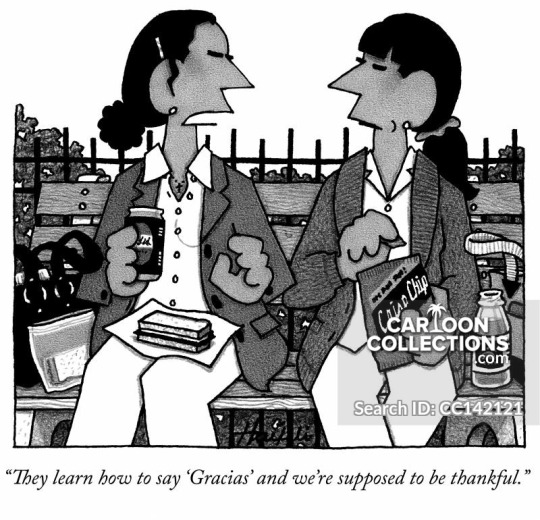
Borderlands Blog
Ch. #5: How to Tame a Wild Tongue
This chapter focuses on Anzaldua’s experiences with being punished for speaking Spanish. I think that the most interesting quote from this chapter is, “Wild tongues can’t be tamed, they can only be cut out” (76). This quote really struck a chord with me. Though I am white, and only speak English, that does not stop me from being able to understand that it is wrong to punish someone for speaking a different language. I also am able to understand what a privilege it is for me to be able to speak my first language and not be judged or punished for it. I work in customer service and have had a lot of experiences where an individual, whether it be a customer or guest at one of my tables, only spoke Spanish or some English. I remember the look in their eyes as they tried to communicate with me, or if it was a parent I remember how mature it seemed for the child to be their translator. I took some Spanish in High School so I understand the basics, but I still find it hard for me to accomodate Spanish speaking individuals. I often would try to find someone that I worked with that knew Spanish and could speak with the customer, so that they could feel how they should feel: like a respected patron in my place of work that deserves superior service. I did not want to insult the customer by trying to reply in sloppy Spanish or by having to ask them to repeat themselves. I would get kind of embarassed when I could not understand them. I imagine that if more people had a compassionate outlook on language and appreciated the diversity of the languages in the United States instead of trying to force someone into learning their language just because its easier for them, we would have a lot less language-based prejudice. I chose this political cartoon for this blog post because I think it represents that false sense of pride that English-Speaking U.S. citizens get when they try to speak in Spanish, but it also reminds me that we can’t be patronizing or condescending when trying to speak to someone in a language we don’t know. Some people act like they are accomodating them, but I think this extends further than language. I think if you are trying to promote equality and treating others equally despite the language they speak, you also need to promote equality for those peoples in other forms of oppression they speak.
0 notes
Photo
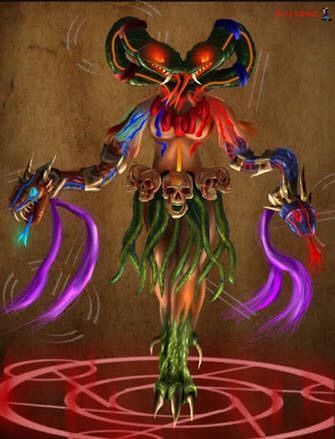
Borderlands Blog
Ch. #4 La herencia de Coatlicue
Anzaldua describes Coatlicue as the “symbol of the underground aspects of the psyche” (68). She basically represents the duality of life. Coatlicue seems to be a very important topic within the senses of this book because the concept of borderland citizens involves the duality of what is accepted and what is not. I think that Coatlicue is an important way of symbolizing this separation because she represents opposites and contradicting things. I chose this picture to put with this post because I feel that this is what best represents what I was imagining Coatlicue looking like while reading this chapter. It is interesting to me because she has the body parts of a woman that are typically the most focused on by cultures that sexualize women but also has animal aspects to her body as well. I think that this also calls back to chapter 2 when Anzaldua discusses the Shadow-Beast and how females are males’ Shadow-Beast. Coatlicue reminds me of a powerful female animal creature that in her very appearance reminds us to think about our competing ideas.
0 notes
Photo
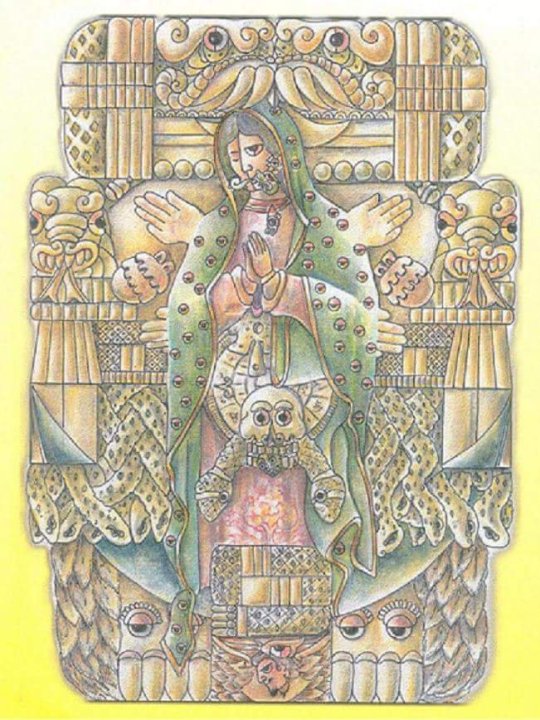
Borderlands Blog
Ch. #3: Entering Into the Serpent
In this chapter, Anzaldua examines the different religious views and the evolution of dieties in Aztec and Mexica culture. One very interesting point that was made was, “In trying to become ‘objective,’ Western culture made ‘objects’ of things and people when it distanced itself from them, thereby losing ‘touch’ with them. This dichotomy is the root of all violence” (59). This quote is very relevant to the themes of the book and I connect to it as well because I have been learning a lot about the histories of how colonization and western culture have impacted other cultures history. I think that the involvement of western culture and its religions has impacted these Aztec religions and has expanded the patriarchal ideologies and has influenced further oppression of women. I also feel that this chapter further drives home the idea of othering people, more specifically the idea of western culture othering the spirituality of indigenous people in their colonization of North America. I think that European people thought that their ideas were so advanced when really their religious beliefs were a lot more closed off and narrow-minded because they did not believe in the spirituality of other beings than themselves and the idea that a spirit or divine entity exists all throughout our environments, not just up in heaven.
0 notes
Photo

Borderlands Blog
Ch. #2: Movimientos de rebeldia y las culturas que traicionan
In this chapter, Anzaldua discusses her decision to leave home, and attributes her seeking of freedom to an element within her that craves freedom and always breaks from the chains that constrain her, the Shadow-Beast. She describes the Shadow-Beast as something that “refuses to take orders from outside authorities. It refuses to take orders from my conscious will, it threatens the sovereignty of my rulership” (38). Then, Anzaldua goes on to explain how human beings are scared of the divine and undivine supernatural. She explains that the undivine supernatural are things like sexuality and the unknown, and that the divine supernatural are the god or superhuman in ourselves. Then Anzaldua describes a woman as being supernatural. A female is divine in her ability to create life but also undivine in her connection to nature and animal and taboo in her ability to bleed every month but not die, and to create life. Anzaldua explains how most religions fear the power a female has, and therefore tries to protect her from herself. Anzaldua’s comparison of her own Shadow-Beast to the way the the female is the male’s Shadow-Beast in how she is powerful and can break free from his submission is so perfectly worded and the concept is remarkable. I chose to attach this picture, done by Anzaldua, to this blog post because I think it really embodies the concept and power that a woman has and how that is turned around on her in the form of oppression and othering. The phrase “Tu Cuerpo Es Una Frontera” meaning, “your body is a border” also relevantly connects to the text because this whole book focuses on the different forms of bordered/ othered identities and I think that the very nature of being a female means you are othered by the patriarchy in a male vs. female dynamic.
0 notes
Photo
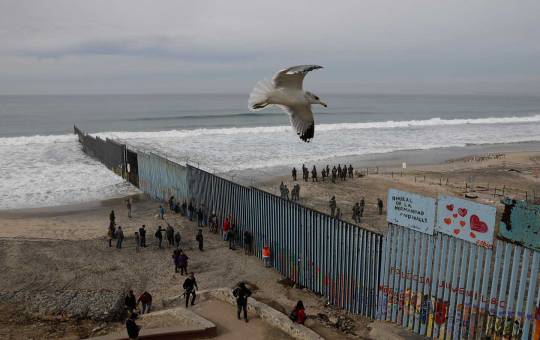
Borderlands Blog
Ch. #1: The Homeland, Aztlan
In this first chapter, Gloria Anzaldua gives a description of a borderland. I really found the description interesting. The visual images created when reading, “Borders are set up to define the places that are safe or unsafe, to distinguish us from them” are both shocking and eye-opening. This description of a borderland, especially the borderland between the U.S. and Mexico as being a scab is very interesting to me because it truly is the rougher edge of the Southern U.S. border scraping against the Borderland of Mexico. Anzaldua also describes the people who live in these borderlands as everyone who may be categorized outside of the normal. This is very thought-provoking for me because I have come to understand a lot more in my studies how people are “othered” from the expected norms and values of their culture. So it is very interesting to think about the people who reside in or identify with these borderlands because they are othered from the U.S. but also may be othered from Mexico or their Chicano heritage because of some other intersecting identity that they may have. The definition of a borderland to me also comes across as not just a physical place but also a mental and emotional identity or way of being categorized.
1 note
·
View note